[English] 日本語
 Yorodumi
Yorodumi- PDB-5d3e: Crystal structure of human 14-3-3 gamma in complex with CFTR R-do... -
+ Open data
Open data
- Basic information
Basic information
| Entry | Database: PDB / ID: 5d3e | ||||||
|---|---|---|---|---|---|---|---|
| Title | Crystal structure of human 14-3-3 gamma in complex with CFTR R-domain peptide pS768-pS795 | ||||||
 Components Components |
| ||||||
 Keywords Keywords | SIGNALING PROTEIN / protein-peptide complex / phosphorylation / tandem binding | ||||||
| Function / homology |  Function and homology information Function and homology informationpositive regulation of voltage-gated chloride channel activity / : / Sec61 translocon complex binding / channel-conductance-controlling ATPase / intracellularly ATP-gated chloride channel activity / positive regulation of enamel mineralization / transepithelial water transport / RHO GTPases regulate CFTR trafficking / positive regulation of cell-cell adhesion / amelogenesis ...positive regulation of voltage-gated chloride channel activity / : / Sec61 translocon complex binding / channel-conductance-controlling ATPase / intracellularly ATP-gated chloride channel activity / positive regulation of enamel mineralization / transepithelial water transport / RHO GTPases regulate CFTR trafficking / positive regulation of cell-cell adhesion / amelogenesis / phosphorylation-dependent protein binding / intracellular pH elevation / chloride channel inhibitor activity / : / multicellular organismal-level water homeostasis / Golgi-associated vesicle membrane / positive regulation of T cell mediated immune response to tumor cell / cholesterol transport / bicarbonate transport / bicarbonate transmembrane transporter activity / chloride channel regulator activity / membrane hyperpolarization / vesicle docking involved in exocytosis / regulation of neuron differentiation / chloride transmembrane transporter activity / sperm capacitation / cholesterol biosynthetic process / protein kinase C inhibitor activity / RHOQ GTPase cycle / chloride channel activity / Regulation of localization of FOXO transcription factors / positive regulation of exocytosis / ATPase-coupled transmembrane transporter activity / Activation of BAD and translocation to mitochondria / regulation of signal transduction / chloride channel complex / positive regulation of insulin secretion involved in cellular response to glucose stimulus / ABC-type transporter activity / Chk1/Chk2(Cds1) mediated inactivation of Cyclin B:Cdk1 complex / SARS-CoV-2 targets host intracellular signalling and regulatory pathways / protein targeting / negative regulation of protein kinase activity / cellular response to glucose starvation / RHO GTPases activate PKNs / SARS-CoV-1 targets host intracellular signalling and regulatory pathways / 14-3-3 protein binding / insulin-like growth factor receptor binding / negative regulation of TORC1 signaling / Loss of Nlp from mitotic centrosomes / Loss of proteins required for interphase microtubule organization from the centrosome / Transcriptional and post-translational regulation of MITF-M expression and activity / Recruitment of mitotic centrosome proteins and complexes / Recruitment of NuMA to mitotic centrosomes / cellular response to forskolin / Anchoring of the basal body to the plasma membrane / protein sequestering activity / chloride transmembrane transport / protein kinase C binding / cellular response to cAMP / response to endoplasmic reticulum stress / AURKA Activation by TPX2 / TP53 Regulates Metabolic Genes / Translocation of SLC2A4 (GLUT4) to the plasma membrane / PDZ domain binding / establishment of localization in cell / clathrin-coated endocytic vesicle membrane / Defective CFTR causes cystic fibrosis / Late endosomal microautophagy / recycling endosome / regulation of synaptic plasticity / receptor tyrosine kinase binding / positive regulation of T cell activation / ABC-family proteins mediated transport / transmembrane transport / cellular response to insulin stimulus / recycling endosome membrane / Chaperone Mediated Autophagy / Aggrephagy / intracellular protein localization / Regulation of PLK1 Activity at G2/M Transition / Cargo recognition for clathrin-mediated endocytosis / presynapse / protein-folding chaperone binding / regulation of protein localization / Clathrin-mediated endocytosis / early endosome membrane / early endosome / endosome membrane / Ub-specific processing proteases / apical plasma membrane / mitochondrial matrix / protein domain specific binding / lysosomal membrane / focal adhesion / endoplasmic reticulum membrane / enzyme binding / cell surface / signal transduction / ATP hydrolysis activity / protein-containing complex Similarity search - Function | ||||||
| Biological species |  Homo sapiens (human) Homo sapiens (human) | ||||||
| Method |  X-RAY DIFFRACTION / X-RAY DIFFRACTION /  SYNCHROTRON / SYNCHROTRON /  MOLECULAR REPLACEMENT / Resolution: 2.75 Å MOLECULAR REPLACEMENT / Resolution: 2.75 Å | ||||||
 Authors Authors | Stevers, L.M. / Leysen, S.F.R. / Ottmann, C. | ||||||
 Citation Citation |  Journal: Proc.Natl.Acad.Sci.USA / Year: 2016 Journal: Proc.Natl.Acad.Sci.USA / Year: 2016Title: Characterization and small-molecule stabilization of the multisite tandem binding between 14-3-3 and the R domain of CFTR. Authors: Stevers, L.M. / Lam, C.V. / Leysen, S.F. / Meijer, F.A. / van Scheppingen, D.S. / de Vries, R.M. / Carlile, G.W. / Milroy, L.G. / Thomas, D.Y. / Brunsveld, L. / Ottmann, C. | ||||||
| History |
|
- Structure visualization
Structure visualization
| Structure viewer | Molecule:  Molmil Molmil Jmol/JSmol Jmol/JSmol |
|---|
- Downloads & links
Downloads & links
- Download
Download
| PDBx/mmCIF format |  5d3e.cif.gz 5d3e.cif.gz | 291.2 KB | Display |  PDBx/mmCIF format PDBx/mmCIF format |
|---|---|---|---|---|
| PDB format |  pdb5d3e.ent.gz pdb5d3e.ent.gz | 238.8 KB | Display |  PDB format PDB format |
| PDBx/mmJSON format |  5d3e.json.gz 5d3e.json.gz | Tree view |  PDBx/mmJSON format PDBx/mmJSON format | |
| Others |  Other downloads Other downloads |
-Validation report
| Arichive directory |  https://data.pdbj.org/pub/pdb/validation_reports/d3/5d3e https://data.pdbj.org/pub/pdb/validation_reports/d3/5d3e ftp://data.pdbj.org/pub/pdb/validation_reports/d3/5d3e ftp://data.pdbj.org/pub/pdb/validation_reports/d3/5d3e | HTTPS FTP |
|---|
-Related structure data
| Related structure data | 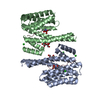 5d2dC  5d3fC  4uzdS S: Starting model for refinement C: citing same article ( |
|---|---|
| Similar structure data |
- Links
Links
- Assembly
Assembly
| Deposited unit | 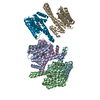
| ||||||||
|---|---|---|---|---|---|---|---|---|---|
| 1 | 
| ||||||||
| 2 | 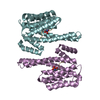
| ||||||||
| 3 | 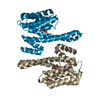
| ||||||||
| Unit cell |
|
- Components
Components
| #1: Protein | Mass: 27738.176 Da / Num. of mol.: 6 Source method: isolated from a genetically manipulated source Source: (gene. exp.)  Homo sapiens (human) / Gene: YWHAG / Production host: Homo sapiens (human) / Gene: YWHAG / Production host:  #2: Protein/peptide | Mass: 4668.073 Da / Num. of mol.: 3 / Fragment: UNP residues 762-801 / Source method: obtained synthetically / Source: (synth.)  Homo sapiens (human) / References: UniProt: P13569, EC: 3.6.3.49 Homo sapiens (human) / References: UniProt: P13569, EC: 3.6.3.49#3: Water | ChemComp-HOH / | Has protein modification | Y | |
|---|
-Experimental details
-Experiment
| Experiment | Method:  X-RAY DIFFRACTION X-RAY DIFFRACTION |
|---|
- Sample preparation
Sample preparation
| Crystal | Density Matthews: 3.09 Å3/Da / Density % sol: 60.23 % |
|---|---|
| Crystal grow | Temperature: 293 K / Method: vapor diffusion, sitting drop / pH: 7.5 Details: HEPES, NaCl, DTT, (NH4)2SO4, Poly(acrylic acid sodium salt 2100 |
-Data collection
| Diffraction | Mean temperature: 100 K | |||||||||||||||||||||||||||
|---|---|---|---|---|---|---|---|---|---|---|---|---|---|---|---|---|---|---|---|---|---|---|---|---|---|---|---|---|
| Diffraction source | Source:  SYNCHROTRON / Site: SYNCHROTRON / Site:  SLS SLS  / Beamline: X10SA / Wavelength: 0.97886 Å / Beamline: X10SA / Wavelength: 0.97886 Å | |||||||||||||||||||||||||||
| Detector | Type: PSI PILATUS 6M / Detector: PIXEL / Date: Dec 8, 2014 | |||||||||||||||||||||||||||
| Radiation | Protocol: SINGLE WAVELENGTH / Monochromatic (M) / Laue (L): M / Scattering type: x-ray | |||||||||||||||||||||||||||
| Radiation wavelength | Wavelength: 0.97886 Å / Relative weight: 1 | |||||||||||||||||||||||||||
| Reflection | Resolution: 2.75→36.3 Å / Num. obs: 62906 / % possible obs: 100 % / Redundancy: 13.6 % / Biso Wilson estimate: 53.42 Å2 / CC1/2: 0.998 / Rmerge(I) obs: 0.12 / Rpim(I) all: 0.034 / Net I/σ(I): 15.6 / Num. measured all: 856403 / Scaling rejects: 32 | |||||||||||||||||||||||||||
| Reflection shell | Diffraction-ID: 1 / Rejects: _
|
- Processing
Processing
| Software |
| ||||||||||||||||||||||||||||||||||||||||||||||||||||||||||||||||||||||||||||||||||||||||||||||||||||||||||||||||||||||||||||||||||||||||||
|---|---|---|---|---|---|---|---|---|---|---|---|---|---|---|---|---|---|---|---|---|---|---|---|---|---|---|---|---|---|---|---|---|---|---|---|---|---|---|---|---|---|---|---|---|---|---|---|---|---|---|---|---|---|---|---|---|---|---|---|---|---|---|---|---|---|---|---|---|---|---|---|---|---|---|---|---|---|---|---|---|---|---|---|---|---|---|---|---|---|---|---|---|---|---|---|---|---|---|---|---|---|---|---|---|---|---|---|---|---|---|---|---|---|---|---|---|---|---|---|---|---|---|---|---|---|---|---|---|---|---|---|---|---|---|---|---|---|---|---|
| Refinement | Method to determine structure:  MOLECULAR REPLACEMENT MOLECULAR REPLACEMENTStarting model: 4UZD Resolution: 2.75→36.3 Å / FOM work R set: 0.8089 / SU ML: 0.4 / Cross valid method: NONE / σ(F): 1.34 / Phase error: 25.12 / Stereochemistry target values: ML
| ||||||||||||||||||||||||||||||||||||||||||||||||||||||||||||||||||||||||||||||||||||||||||||||||||||||||||||||||||||||||||||||||||||||||||
| Solvent computation | Shrinkage radii: 0.9 Å / VDW probe radii: 1.11 Å / Solvent model: FLAT BULK SOLVENT MODEL | ||||||||||||||||||||||||||||||||||||||||||||||||||||||||||||||||||||||||||||||||||||||||||||||||||||||||||||||||||||||||||||||||||||||||||
| Displacement parameters | Biso max: 174.75 Å2 / Biso mean: 63.19 Å2 / Biso min: 13.16 Å2 | ||||||||||||||||||||||||||||||||||||||||||||||||||||||||||||||||||||||||||||||||||||||||||||||||||||||||||||||||||||||||||||||||||||||||||
| Refinement step | Cycle: final / Resolution: 2.75→36.3 Å
| ||||||||||||||||||||||||||||||||||||||||||||||||||||||||||||||||||||||||||||||||||||||||||||||||||||||||||||||||||||||||||||||||||||||||||
| Refine LS restraints |
| ||||||||||||||||||||||||||||||||||||||||||||||||||||||||||||||||||||||||||||||||||||||||||||||||||||||||||||||||||||||||||||||||||||||||||
| LS refinement shell | Refine-ID: X-RAY DIFFRACTION / Total num. of bins used: 22 / % reflection obs: 100 %
|
 Movie
Movie Controller
Controller


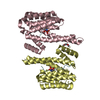
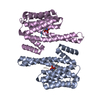



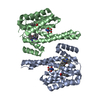

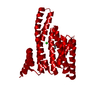
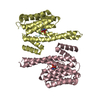

 PDBj
PDBj








